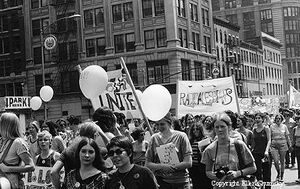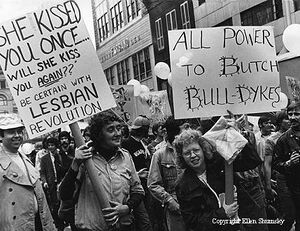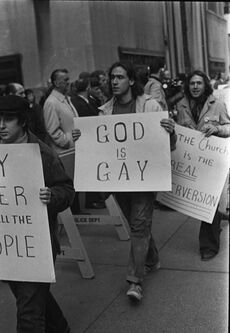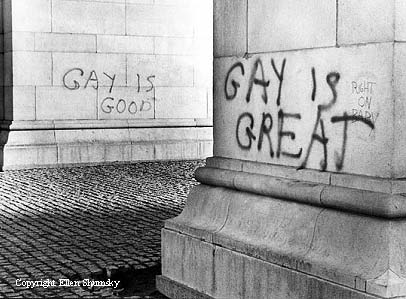Difference between revisions of "Gay Liberation in New York City"
| (20 intermediate revisions by 4 users not shown) | |||
| Line 2: | Line 2: | ||
===Introduction=== | ===Introduction=== | ||
| + | On June 27th, 1969, seven officers from the Public Morals Section of the New York City Police Department raided the Stonewall Inn, a gay bar in New York City’s Greenwich Village. [[Image:Radicalesbians CSLD.jpg|thumb|right|The first [[Christopher Street Liberation Day March]]. June 28, 1970. Copyright Ellen Shumsky. Courtesy of the photographer.]]The raid sparked a three-day rebellion against the police—the largest and most sustained uprising among gays, lesbians, and transgender individuals to that point. And although it did not mark the beginning of New York’s LGBT movement—members of the [http://www.glbtq.com/social-sciences/mattachine_society.html Mattachine Society] of New York (MSNY) and the [http://www.glbtq.com/social-sciences/daughters_bilitis.html Daughters of Bilitis] (DOB) had been fighting for civil rights for years when Stonewall took place—it did initiate a new wave of activism, one that differed markedly from the homophile movements that preceded it. | ||
| − | + | In the years following Stonewall, LGBT individuals organized on unprecedented levels, forging new forms of activism that would change the direction of the movement and the consciousness of a generation. New York City was central to this period of activism, giving birth not only to the first gay liberation group in the country—the [[Gay Liberation Front]] (GLF), organized a mere month after Stonewall—but also to myriad groups to follow, such as the [[Gay Activists Alliance]] (GAA), [[Radicalesbians]] (RL), [[Third World Gay Revolution]] (TWGR), [[Street Transvestite Action Revolutionaries]] (STAR), [[The Effeminists]], and many more. | |
| − | |||
| − | This exhibit will focus on the strain of activism that dominated the gay political scene in New York City and across the country from 1969-1973: Gay Liberation. The movement that emerged out of Stonewall was unique in the emphasis it placed on empowering gays, lesbians, and transgender individuals to come out, be proud, and fight back against oppression. But the movement never coalesced around a dominant political philosophy or organizational strategy, and fierce debates—both within and among different groups—persisted throughout the 1970s. Additionally, activists splintered along race, class, and gender lines, with women, people of color, and transgender people breaking off from existing groups to organize around their own identities and struggle against their particular oppressions. | + | [[Image:Gay Pride March 1972.jpg|thumb|left|[[Christopher Street Liberation Day March]]. June 25, 1972. Copyright Ellen Shumsky. Courtesy of the photographer.]]This exhibit will focus on the strain of activism that dominated the gay political scene in New York City and across the country from 1969-1973: Gay Liberation. The movement that emerged out of Stonewall was unique in the emphasis it placed on empowering gays, lesbians, and transgender individuals to come out, be proud, and fight back against oppression. But the movement never coalesced around a dominant political philosophy or organizational strategy, and fierce debates—both within and among different groups—persisted throughout the 1970s. Additionally, activists splintered along race, class, and gender lines, with women, people of color, and transgender people breaking off from existing groups to organize around their own identities and struggle against their particular oppressions. |
| + | |||
By examining this early period of activism in New York City in all of its complexity, this exhibit will shed light on a critical juncture in the LGBT movement—both its successes and shortcomings—and, in doing so, glimpse at what may yet be possible. | By examining this early period of activism in New York City in all of its complexity, this exhibit will shed light on a critical juncture in the LGBT movement—both its successes and shortcomings—and, in doing so, glimpse at what may yet be possible. | ||
| + | ===The Activists=== | ||
| + | |||
| + | [http://www.youtube.com/watch?v=I8KvJRLgK6A| The gay liberationists who participated in this exhibit talk in video interviews about what the movement meant to them.] | ||
| + | |||
| + | They are, in order of appearance: | ||
| − | + | Kenneth Pitchford (of the [[Gay Liberation Front]] and [[The Effeminists]]); | |
| + | |||
| + | Karla Jay (of the GLF and [[Radicalesbians]]); | ||
| + | |||
| + | Perry Brass (of GLF); Rich Wandel (of the [[Gay Activists Alliance]]); | ||
| + | Ellen Shumsky (of GLF and RL); | ||
| − | + | Bebe Scarpi (of GAA and the [[Street Transvestite Action Revolutionaries]]); | |
| + | Michael Lavery (of GLF and GAA); and Jerry Hoose (of GLF). | ||
| − | + | The photographs used for Ellen Shumsky's and Bebe Scarpi's interviews were taken by Richard C. Wandel. Courtesy of the Lesbian, Gay, Bisexual & Transgender Community Center National History Archive. | |
| − | |||
| − | |||
===Timeline=== | ===Timeline=== | ||
| + | '''June 27-29, 1969:''' Gays, lesbians, and transgender individuals fight back against the police after a raid on the gay bar the Stonewall Inn. | ||
| + | |||
| + | [[Image:God is Gay.jpg|thumb|right|upright|A [[Gay Liberation Front]] demonstration at St. Patrick's Cathedral. Fall 1970. Photograph by Richard C. Wandel. Courtesy of the Lesbian, Gay, Bisexual & Transgender Community Center National History Archive.]] '''July 31, 1969:''' In response to the Stonewall Rebellion, a group of gays and lesbians form the [[Gay Liberation Front]] (GLF). | ||
| − | |||
| − | ''' | + | '''December 21, 1969:''' Marty Robinson, Jim Owles, and ten others approve the constitution for the newly-formed [[Gay Activists Alliance]] (GAA). |
| − | |||
'''May 1, 1970:''' A group of lesbians from the gay and women's liberation movements take over the Second Congress to Unite Women, initiating a conversation about lesbianism among conference participants. [[Radicalesbians]] (RL) is formed out of this action. | '''May 1, 1970:''' A group of lesbians from the gay and women's liberation movements take over the Second Congress to Unite Women, initiating a conversation about lesbianism among conference participants. [[Radicalesbians]] (RL) is formed out of this action. | ||
| + | |||
'''June 28, 1970:''' The First Annual [[Christopher Street Liberation Day March]] is held. | '''June 28, 1970:''' The First Annual [[Christopher Street Liberation Day March]] is held. | ||
| + | |||
'''July 1970:''' Members of the [[Gay Liberation Front]] form the [[Third World Gay Revolution]] (TWGR). | '''July 1970:''' Members of the [[Gay Liberation Front]] form the [[Third World Gay Revolution]] (TWGR). | ||
| + | |||
'''September 20-25, 1970:''' Gay liberationists hold a five-day sit-in at NYU’s Weinstein Hall to protest the cancellation of gay dances there. [[Street Transvestite Action Revolutionaries]] (STAR) is formed out of this protest. | '''September 20-25, 1970:''' Gay liberationists hold a five-day sit-in at NYU’s Weinstein Hall to protest the cancellation of gay dances there. [[Street Transvestite Action Revolutionaries]] (STAR) is formed out of this protest. | ||
| − | |||
| − | ''' | + | '''January 6, 1971:''' City Council Members Eldon Clingan and Carter Burden introduce a bill—Intro 475—to include sexual orientation in New York’s Human Rights Law. |
| − | |||
| − | '''1973:''' Former GLFers Steven Dansky, John Knoebel, and Kenneth Pitchford lay out the vision of [[The Effeminists]] in their Effeminist Manifesto. | + | '''October-December 1971:''' Three days of public hearings on Intro 475 are held. |
| + | |||
| + | |||
| + | '''January 27, 1972:''' The City Council’s General Welfare Committee votes against bringing Intro 475 to the full council. | ||
| + | |||
| + | |||
| + | '''January 1, 1973:''' Former GLFers Steven Dansky, John Knoebel, and Kenneth Pitchford lay out the vision of [[The Effeminists]] in their Effeminist Manifesto. | ||
| + | |||
===Exhibit Pages=== | ===Exhibit Pages=== | ||
| − | |||
[[Gay Liberation Front]] | [[Gay Liberation Front]] | ||
| Line 58: | Line 76: | ||
[[Radicalesbians]] | [[Radicalesbians]] | ||
| + | |||
| + | [[Third World Gay Revolution]] | ||
[[Street Transvestite Action Revolutionaries]] | [[Street Transvestite Action Revolutionaries]] | ||
| Line 64: | Line 84: | ||
[[Christopher Street Liberation Day March]] | [[Christopher Street Liberation Day March]] | ||
| + | |||
| + | [[Come Out!]] | ||
[[Consciousness-Raising]] | [[Consciousness-Raising]] | ||
| − | [[ | + | [[Further Resources]] |
| + | |||
| + | |||
| + | ===Acknowledgments=== | ||
| + | Many thanks to Ellen Shumsky, Richard Wandel, Steven Danksy, Perry Brass, and the Lesbian Herstory Archives for granting me permission to use the images that appear on this exhibit. Special thanks to the team at the Lesbian, Gay, Bisexual & Transgender Community Center National History Archive for generously volunteering their time to scan Richard C. Wandel's photographs. Finally, thanks to Kody Trauger, without whose technical assistance this exhibit would not have been possible. | ||
| + | |||
===Categories=== | ===Categories=== | ||
| Line 79: | Line 106: | ||
Street Transvestite Action Revolutionaries, | Street Transvestite Action Revolutionaries, | ||
The Effeminists, | The Effeminists, | ||
| − | Christopher Street Liberation Day March | + | Christopher Street Liberation Day March |
| + | |||
===Contact=== | ===Contact=== | ||
| − | + | Lindsay Branson: lindsay.branson@gmail.com | |
| + | __NOTOC__ | ||
Latest revision as of 10:14, 1 October 2011
Introduction
On June 27th, 1969, seven officers from the Public Morals Section of the New York City Police Department raided the Stonewall Inn, a gay bar in New York City’s Greenwich Village.

The raid sparked a three-day rebellion against the police—the largest and most sustained uprising among gays, lesbians, and transgender individuals to that point. And although it did not mark the beginning of New York’s LGBT movement—members of the Mattachine Society of New York (MSNY) and the Daughters of Bilitis (DOB) had been fighting for civil rights for years when Stonewall took place—it did initiate a new wave of activism, one that differed markedly from the homophile movements that preceded it.
In the years following Stonewall, LGBT individuals organized on unprecedented levels, forging new forms of activism that would change the direction of the movement and the consciousness of a generation. New York City was central to this period of activism, giving birth not only to the first gay liberation group in the country—the Gay Liberation Front (GLF), organized a mere month after Stonewall—but also to myriad groups to follow, such as the Gay Activists Alliance (GAA), Radicalesbians (RL), Third World Gay Revolution (TWGR), Street Transvestite Action Revolutionaries (STAR), The Effeminists, and many more.

This exhibit will focus on the strain of activism that dominated the gay political scene in New York City and across the country from 1969-1973: Gay Liberation. The movement that emerged out of Stonewall was unique in the emphasis it placed on empowering gays, lesbians, and transgender individuals to come out, be proud, and fight back against oppression. But the movement never coalesced around a dominant political philosophy or organizational strategy, and fierce debates—both within and among different groups—persisted throughout the 1970s. Additionally, activists splintered along race, class, and gender lines, with women, people of color, and transgender people breaking off from existing groups to organize around their own identities and struggle against their particular oppressions.
By examining this early period of activism in New York City in all of its complexity, this exhibit will shed light on a critical juncture in the LGBT movement—both its successes and shortcomings—and, in doing so, glimpse at what may yet be possible.
The Activists
They are, in order of appearance:
Kenneth Pitchford (of the Gay Liberation Front and The Effeminists);
Karla Jay (of the GLF and Radicalesbians);
Perry Brass (of GLF); Rich Wandel (of the Gay Activists Alliance);
Ellen Shumsky (of GLF and RL);
Bebe Scarpi (of GAA and the Street Transvestite Action Revolutionaries);
Michael Lavery (of GLF and GAA); and Jerry Hoose (of GLF).
The photographs used for Ellen Shumsky's and Bebe Scarpi's interviews were taken by Richard C. Wandel. Courtesy of the Lesbian, Gay, Bisexual & Transgender Community Center National History Archive.
Timeline
June 27-29, 1969: Gays, lesbians, and transgender individuals fight back against the police after a raid on the gay bar the Stonewall Inn.

July 31, 1969: In response to the Stonewall Rebellion, a group of gays and lesbians form the Gay Liberation Front (GLF).
December 21, 1969: Marty Robinson, Jim Owles, and ten others approve the constitution for the newly-formed Gay Activists Alliance (GAA).
May 1, 1970: A group of lesbians from the gay and women's liberation movements take over the Second Congress to Unite Women, initiating a conversation about lesbianism among conference participants. Radicalesbians (RL) is formed out of this action.
June 28, 1970: The First Annual Christopher Street Liberation Day March is held.
July 1970: Members of the Gay Liberation Front form the Third World Gay Revolution (TWGR).
September 20-25, 1970: Gay liberationists hold a five-day sit-in at NYU’s Weinstein Hall to protest the cancellation of gay dances there. Street Transvestite Action Revolutionaries (STAR) is formed out of this protest.
January 6, 1971: City Council Members Eldon Clingan and Carter Burden introduce a bill—Intro 475—to include sexual orientation in New York’s Human Rights Law.
October-December 1971: Three days of public hearings on Intro 475 are held.
January 27, 1972: The City Council’s General Welfare Committee votes against bringing Intro 475 to the full council.
January 1, 1973: Former GLFers Steven Dansky, John Knoebel, and Kenneth Pitchford lay out the vision of The Effeminists in their Effeminist Manifesto.
Exhibit Pages
Street Transvestite Action Revolutionaries
Christopher Street Liberation Day March
Acknowledgments
Many thanks to Ellen Shumsky, Richard Wandel, Steven Danksy, Perry Brass, and the Lesbian Herstory Archives for granting me permission to use the images that appear on this exhibit. Special thanks to the team at the Lesbian, Gay, Bisexual & Transgender Community Center National History Archive for generously volunteering their time to scan Richard C. Wandel's photographs. Finally, thanks to Kody Trauger, without whose technical assistance this exhibit would not have been possible.
Categories
Gay Liberation, Stonewall, New York City, Gay Liberation Front, Gay Activists Alliance, Radicalesbians, Third World Gay Revolution, Street Transvestite Action Revolutionaries, The Effeminists, Christopher Street Liberation Day March
Contact
Lindsay Branson: lindsay.branson@gmail.com
